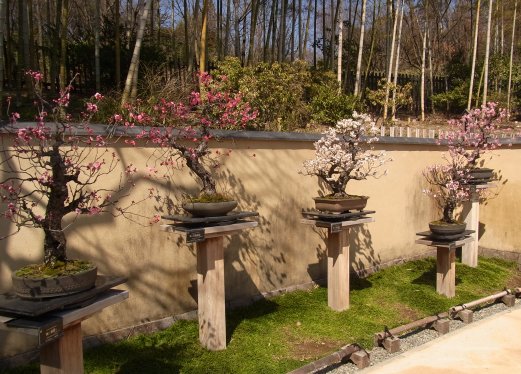
中国の「唐王朝(618-907)」の時代の壁画に「盆栽」が描かれています。
“Bonsai 盆栽 Tray planting” is depicted on the mural paintings of the Chinese “Tang
(618-907) 唐王朝 Dynasty”.
「平安時代(794-1185)」の末までには中国から日本へ「盆栽」が伝えられたと考えられます。
By the end of the “Heian-jidai 平安時代 Period (794-1185)”, it is thought that
“Bonsai” was transmitted from China to Japan.
A
picture of “Bonsai 盆栽” appeared in “E-makimono 絵巻物 Picture scroll” drawn in “Kamakura-jidai 鎌倉時代 Period (1185-1333)”.
The
Jesuit missionary Francisco Xavier (1506-1552) came to Japan in 1549 for
propaganda.
ルイス・フロイス(1532-1597)は、1563 年に「長崎」に上陸して、「戦国時代」の日本で布教活動をして、『日本史』を著しました。
Louis Floyce (1532-1597) landed “Nagasaki 長崎” in 1563 and missioned in Japan during “Sengoku-jidai 戦国時代 Period”and wrote “Historia de Japam”.
「イエズス会」の宣教師らが著した辞書に「盆山」という項目があります。
A
dictionary written by missionaries of the Jesuits has an item called “Bonsan 盆山”.
「江戸時代」に入ると、「屏風絵」に「盆栽」が登場します。
From
“Edo-jidai 江戸時代 Period, “Bonsai” appeared in “Byōbu-e 屏風絵 Picture of Folding Screen”
In the middle of “Edo-jidai Period”, “Bonsai”appeared in the picture of
“Daimyo-Yashiki 大名屋敷 Residence”.
「江戸時代」後期には「浮世絵」のモチーフにもなり、「盆栽」は庶民の趣味としても広がっていきました。
In the latter half of “Edo-jidai Period”, “Bonsai” became a motif of “Ukiyo-e
浮世絵 Wood block print” and became popular and spread as a pastime for the common
people.
「江戸時代」末期以降には、「煎茶会」で「座敷」を飾る道具として屋内でも鑑賞されるようになりました。
Since
the end of “Edo-jidai Period, it has also been appreciated indoors as a tool
for decorating “Zashiki 座敷 Tatami room” at
the “Sencha-kai 煎茶会 Tea (middle grade) ceremony”.
“盆栽”是利用栽培技术在浅容器中种植小树,模仿实际树木的大小和形状的日本艺术。
“Bonsai”
is a Japanese art form using cultivation techniques to produce small trees in shallow
containers that mimic the shape and scale of full size trees in nature.
「盆栽」は大自然の中で育った大きな樹木の姿を写し取ります。
“盆栽”移植了在大自然中大树的样子。
“Bonsai” reflect the appearance of mighty trees growing in the wild.
在小花盆里可以再现大自然的雄伟场面。
Within
the confines of their small pots, it's possible to recreate the majestic look
of natural scenes.
“盆栽”的特征是,把草木种在“盆(盆栽盆、盆器)”里,模仿自然的风景进行造型。
“Bonsai” is characterized by planting plants in “Hachi 鉢 Pots (Bonsai pots)” and imitating natural scenery.
“盆栽”是欣赏树枝、树叶、树干的外皮、根以及盆栽容器,或者是整个盆栽姿态的兴趣爱好。
“Bonsai”
is a pastime to appreciate branches, leaves, trunk skin, roots and pots, or the
whole.
因为“盆栽”的管理和培养花费精力和时间,所以盆栽爱好者以中高年人群为中心。
Since
“bonsai” takes time and effort to manage and nurture, lovers are mainly mature.
为了培育小型植物,会运用到品种改良和遗传因子工学。
Plant dwarfing often uses selective breeding or genetic engineering to create dwarf cultivars.
但是,“盆栽”不需要对树从遗传上进行品种改良。
“Bonsai”
does not require genetically dwarfed trees.
むしろ、通常の苗木や種子から小さな木を成長させることが重要です。
倒不如说是,从普通的树苗和种子培育小树更重要。
It is important that you grow small trees from regular seedlings and seeds.
作为范本的盆栽,是熟练的手艺人多年劳动成果的珍贵结晶。
Exceptional examples of “Bonsai” are the outcome of countless years of
care and attention by skilled “Shokunin 職人 Gardener”.
「盆栽」は、生きた植物なので、常に変化するのも魅力の一つで、「完成」というものがありません。
“盆栽”是活生生的植物,经常变化也是它的魅力之一,没有“完成”的说法。
Since “Bonsai” is a living plant, it is one of the attractions that always changes, and there is no “Completeness”.
「盆栽」は、長い時間と手間をかけて、「接木」、「剪定」、「針金掛け」、「根切」、「古葉取り」、「植え替え」、「施肥」、「水やり」など、様々な栽培技術を駆使して作られます。
“盆栽”通过“嫁接”、“修剪”、 “挂钩”、“缩小根系”、“使之落叶”、“移植到盆栽里”、 “施肥”、“浇水”等栽培技术,花费时间和精力制作而成培育小树工序的。
“Bonsai” is made over time and labor, using various cultivation techniques
including “Tsugi-ki 接木 Grafting”, “Sentei 剪定 Pruning”,
“Harigane-kake 針金懸け Wire wraping”, “Ne-giri 根切 Root reduction”, “Furu-ha-tori 古葉取り Defoliation”, “Uekae 植え替え Changing pot”, “Sehi
施肥 Fertilization” and “Mizu-yari 水やり Watering”.
若い枝に針金を巻き付けてイメージした形に整える「針金掛け」は、「盆栽」の基本的なテクニックの一つです。
将铁丝缠绕在新长出的树枝上,培育成设计好的形状,这是盆景的基本技巧之一。
“Harigane-kake Wire wraping” that wrap wires around the young branches
to shape them in whatever way you like is one of the basic
techniques of “Bonsai”.
300年以上の「盆栽」が知られています。
拥有300年以上的历史。
Some “Bonsai” are known for over 300 years.
一鉢の「盆栽」が数百万円から数千万円の値段になることもあります。
One pot of “Bonsai” can command prices in the millions yen, or tens of
millions yen.
また、「盆栽」は誰もが喜んで受け入れることができる趣味でもあります。
另外,“盆栽”也是任何人都能乐于接受的兴趣爱好。
And yet “Bonsai” is also a pastime that anyone can embrace.
大きな庭を持っていない人でも、家の前に置いた棚で「盆栽」を育て、近所の人と育てた「盆栽」について話し合い、育てるコツを共有することができます。
Even people, who don’t have large gardens, can raise “Bonsai” on shelves in front of their houses, chatting about their creations and sharing rips with their neighbors.
「盆栽」を鑑賞するポイントは、樹種によって大きく2つに分かれます。
There
are two main points to appreciate “Bonsai” depending on the tree species.
“Bonsai”,
which is called “shōhaku 松柏”, is an evergreen
conifer, including “Matsu 松 Pine” and “Shinpaku
真柏 Cypress”.
“盆栽”最有代表性的是“松树”。
The most common type of “Bonsai” are “Matsu 松 Pine”.
因为容易栽培,四季长青,所以受欢迎。
Hardy and easy to cultivate, these trees are prized because they stay green
throughout the year.
此外,让人感受到树龄的树皮也很有魅力。
In
addition, their bark develops a venerable appearance that is considered highly
attractive.
歳月を経た幹や枝の一部が枯れ、白く残った部分の枝先を「ジン(神)」、幹を「シャリ(舎利)」と呼びます。
一つの「盆栽」の中に生と死が同居する「神」が造った世界があります。
In one
“Bonsai” there is a world created by “Kami 神 God” where lives and deaths are intermingled together.
「雑木」は、季節ごとに変化を見せる落葉樹が中心です。
「カエデ/モミジ」、「ケヤキ」、「ハゼノキ」、「タケ」などは、「葉姿」を鑑賞する「葉物」です。
“枫”、“榉树”、“枯草树”、“竹子”等是欣赏“树叶姿态”的“观叶植物”。
「モミジ」や「ケヤキ」などの落葉広葉樹は、季節ごとに表情を変えるのが人気です。
“红叶”和“榉树”等落叶阔叶树会根据季节变化树叶颜色,所以很受欢迎。
Deciduous broadleaf trees, such as “Momiji Maple” and “Keyaki Zelkova (tree)”, are also popular because their appearance changes with the seasons.
“梅”、“木瓜”、“樱花”、“皐月”等是赏花的盆栽类型。
“Ume”,
“Bokeh 木瓜”, “Sakura”, “Satsuki” and so on are “Hana-mono
花物 Type of flowers” for appreciation of flowers.
「ウメ」や「サツキ」など、花を楽しむ木や低木も魅力的なタイプの盆栽です。
Flowering trees and shrubs, such as “Ume 梅 Japanese apricots”
and “Satsuki Azaleas”, are other very attractive types of “Bonsai”.

“梅拟”、“柿子”、“花梨”、“姬林檎”等是欣赏果实的盆栽类型。
与欣赏叶子的松树以及其他“盆栽”相比,季节性的花朵会营造出华丽的气氛。
Their seasonal blossoms make a cheerful contrast with the pines and other “Bonsai” that just display their leaves.
「樹形」には、「直幹(ちょっかん)」、「吹き流し」、「懸崖」、「寄せ植え」などがあります。
As “Jukei
樹形
Shape of tree”, there are “Chokkan 直幹 Straight trunk”, “Fukinagashi 吹き流し Streamer”, “Kengai
懸崖
Hanging Cliff-style ”, “Yose-ue 寄せ植えGroup planting” and so on.
「直幹」は、一本の幹が垂直に伸びています。
A “Chokkan
Straight trunk” has a single trunk that extends vertically.
「吹き流し」は、幹や枝が一つの方向に伸び、強い風にあおられたような形です。
“Fukinagashi
Streamer” has a trunk or branches that stretches in one direction by strong
winds.
「懸崖」は、木の先端が大きく垂れ下がり、自然の厳しさや木の生命力が感じられます。
The “Kengai
Hanging Cliff-style” droops the tip of the tree, and you can feel the rigors of
nature and the vitality of the tree.
一見すると不自然に見える場合がありますが、このように自然に成長した多くの樹木を見ることができます。
Although they may appear unnatural at first glance, many trees can be found
growing like this naturally.
「懸崖」は、海岸や渓谷の断崖絶壁に根を張り、風雪などの天候に耐え、幹が下垂して生育を続ける樹木の姿を表現しています。
被称作“悬崖”的“盆栽”,表现了在海岸和溪谷的悬崖绝壁上扎根,承受风雪等天气,生长的树木枝干垂下生长的松树姿态。
“Kengai Hanging
Cliff-style” expresses the shape of a tree that grows on the cliffs of the
coast and the valley and continues to grow with its trunk hanging down, clinging
to sheer cliffs by their roots, weathering gales and blizzards.
「寄せ植え」は、広く浅い「鉢」に複数の「苗木」を植え、森林や山野の趣を表現します。
“Yose-ue
Group planting” is to plant multiple “seedlings” in a wide, shallow “Hachi 鉢 Pot” to express the taste of forests and fields.
1964年に開催された東京オリンピックや、1970年に開催された大阪万博で「盆栽展」が開かれ、「盆栽」が外国人に紹介されました。
「盆栽」は「生きた芸術」と呼ばれて海外でも人気になっています。
“Bonsai”
is called “Living Art” and it has become popular overseas.
イタリアではオリーブの木、南国ではハイビスカスなど、国や地域に寄って様々な樹種が使われています。
Various
tree species are used depending on the country and region, such as olive trees
in Italy and hibiscus in the southern countries.
東京の「団子坂」周辺にいた「盆栽」「職人」が関東大震災を機に埼玉の「大宮」へ移転しました。
“Shokunin
Gardener” of “Bonsai” lived around “Dango-zaka 団子坂 Slope” in Tokyo moved to “Ōmiya 大宮” in Saitama after the Great Kanto Earthquake.
「東京府美術館(現在の東京都美術館)」で、第1回「国風盆栽展」が1934に開催されました。
「国風(こくふう)」とは、その国特有の風習、文化という意味です。
“Kokufū”
means customs and culture unique to the country.